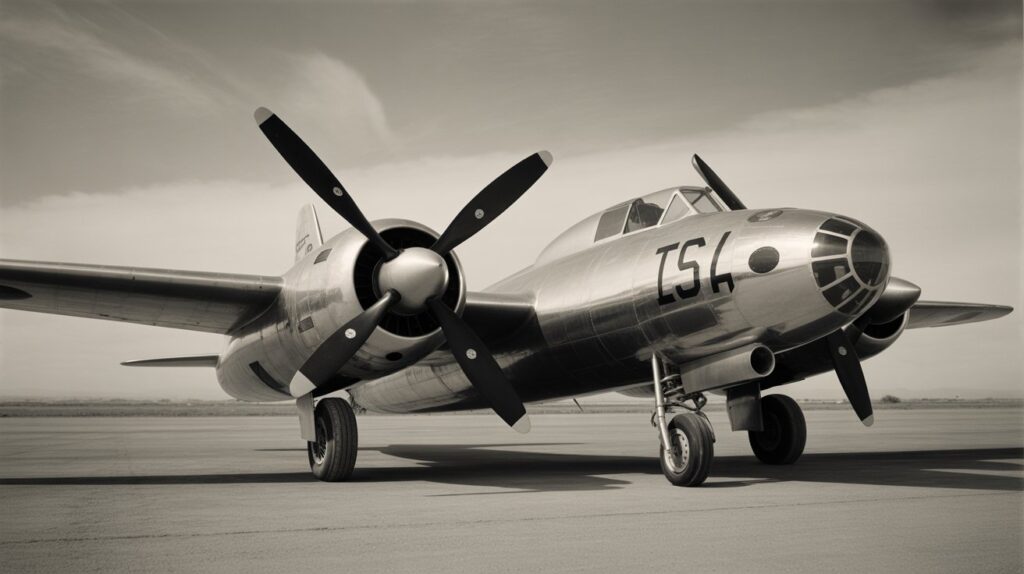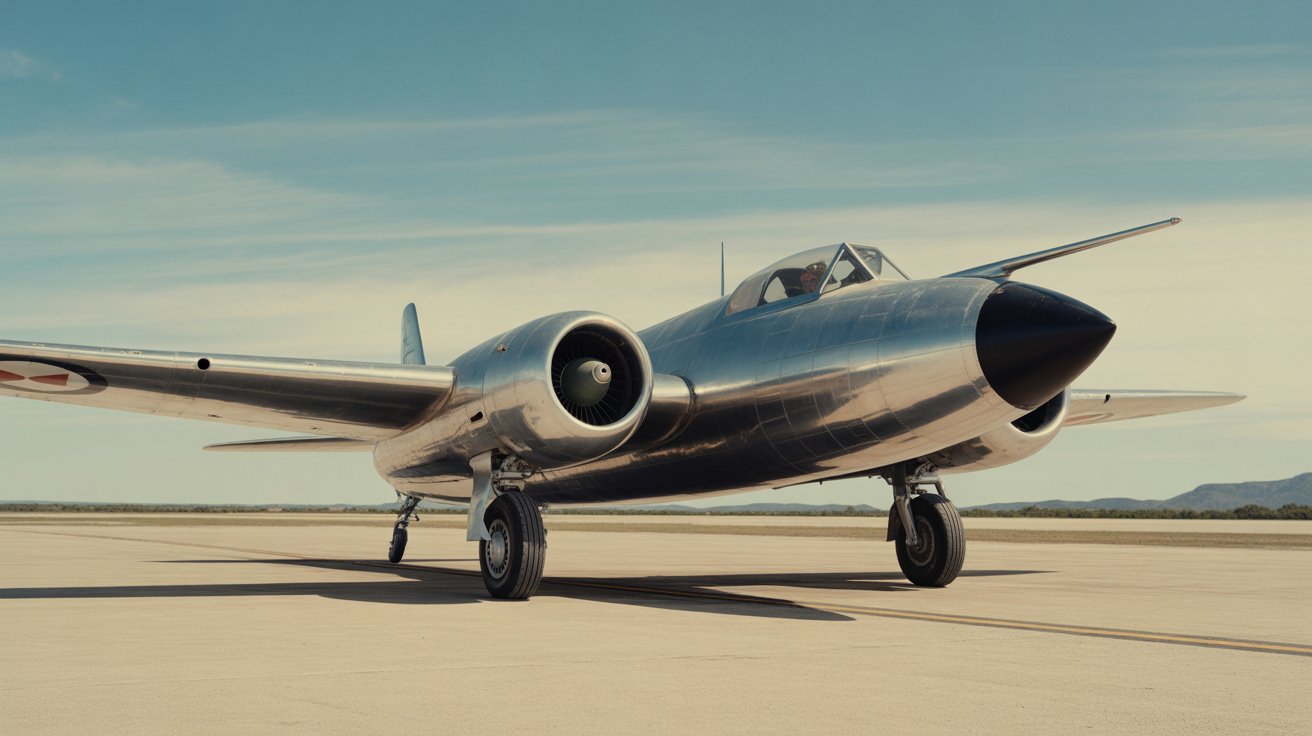The Fairchild Republic XF‑84H Thunderscreech is one of the wildest experiments in aviation history. It was built in the 1950s by modifying a jet‑powered F‑84F Thunderstreak to use a huge turboprop engine, aiming to get both jet speed and propeller power. The idea was cool: a 12‑foot propeller driven by a powerful Allison XT40‑A‑1 engine that could possibly make the prop tips go faster than sound, producing a shockwave and an ear‑splitting noise. Fairchild Republic XF‑84H Thunderscreech was never a success as a fighter, but it left a huge mark because of what it tried and what went wrong. It had problems with vibration, engine reliability, handling, and noise so extreme that people near it got headaches, nausea, or worse. Despite its chaos, it flew twelve times, logged few hours, and one prototype still survives in a museum. We remember it not for victories, but for daring and for being perhaps the loudest aircraft ever made.
Design and Dreams: How the Fairchild Republic XF-84H Thunderscreech Was Built
The Fairchild Republic XF-84H Thunderscreech was built with big dreams. Engineers wanted a fighter plane that could fly very fast but still use a propeller engine. They took the F-84F Thunderstreak jet and turned it into something new by adding a giant turboprop engine and a massive 12-foot propeller. The idea was to mix the best of both worlds — the speed of a jet and the efficiency of a propeller plane. The project started in the early 1950s, during a time when the U.S. Air Force was trying to figure out the future of fighter planes. The plane looked sleek, with long wings and a thin body, but inside it had very powerful machinery. The design was bold, but it also brought problems that nobody had expected, making this one of the strangest planes ever built.
Engine & Propeller: What Made the Thunderscreech So Loud
The most famous thing about the Fairchild Republic XF-84H Thunderscreech was its insane noise. The plane used an Allison XT40-A-1 turboprop engine that created more than 5,000 horsepower. Its propeller was so big and spun so fast that the tips of the blades went past the speed of sound. This made a loud sonic boom every time a blade turned — many times each second! People on the ground said it was the loudest aircraft they had ever heard, and some had to cover their ears from far away. The sound could be felt like a shockwave, shaking windows and even making people feel sick. This noise made it very hard to use the plane safely because it could hurt the ground crew. Even pilots had trouble with the vibrations and the powerful torque that made the plane tricky to control.
Test Flights and Failures: The Struggles of XF-84H Thunderscreech
When the Fairchild Republic XF-84H Thunderscreech went up for testing, it quickly showed its problems. It was hard to handle, and the torque from the big propeller tried to twist the whole plane around. Pilots had to fight just to keep it straight on takeoff. The engine often failed during tests, which made it unsafe. It was also very slow to respond, so pilots worried about crashing if something went wrong. In total, there were twelve flights between the two prototypes, but most flights were cut short because of engine or control issues. Test pilots were brave, but they didn’t enjoy flying this machine. Some flights ended with emergency landings. The plane never reached its promised speed, so the dream of having a “supersonic propeller fighter” was never met. Instead, it became a lesson about the limits of technology in that era.
Noise, Nuisance, and Safety: Ground Crew Tales from the Thunderscreech
The Fairchild Republic XF-84H Thunderscreech was not just loud — it was painfully loud. Ground crew members reported headaches, dizziness, and even nausea when working near it. Some stories claim the noise could be heard 25 miles away! People compared the sound to standing next to a jackhammer but much worse. The shockwaves from the propeller were so strong that they rattled buildings and made conversation impossible. Crew members had to stand very far away during engine start, and some even refused to work on the plane after a while. This made the program harder to continue because safety risks were growing. Even when the plane was not flying, just running the engine on the ground was enough to cause problems. In many ways, the noise was as big a challenge as the engineering failures of the plane itself.

Speed Records That Never Were with the Fairchild Republic XF-84H Thunderscreech
One of the main goals of the Fairchild Republic XF-84H Thunderscreech was to set speed records. The engineers wanted a propeller plane that could go faster than any other, maybe even break the sound barrier in level flight. On paper, the plane looked like it could do it. It had a very powerful engine and a design meant for high speed. But in real life, it never came close to that dream. The plane’s top speed during testing was far lower than expected because of engine problems and drag from the big propeller. The dream of a supersonic propeller plane stayed just a dream. Instead of breaking records, the XF-84H became famous for being too loud and too difficult to fly safely. The idea was ahead of its time, but it simply did not work out in real testing.
Why the XF-84H Thunderscreech Program Was Cancelled
The Fairchild Republic XF-84H Thunderscreech was cancelled for many reasons. First, it was too noisy and dangerous for people around it. The ground crew could not safely work with it, and pilots didn’t like flying it. Second, it failed to meet the speed goals that the Air Force wanted. Jets were getting faster and better during the 1950s, so a propeller fighter no longer made sense. The project cost money but was not giving results, so the Air Force decided to stop wasting resources on it. By the time the program ended, jets like the F-100 Super Sabre were already proving to be the future of air combat. The XF-84H was a brave try, but it was too complicated, too risky, and too late to be useful. Its cancellation was a smart choice for the Air Force at the time.
Legacy and Museum Life of the Fairchild Republic XF-84H Thunderscreech
Even though the Fairchild Republic XF-84H Thunderscreech was a failure, it still has a special place in aviation history. It showed what engineers were willing to try to make aircraft faster and more powerful. Today, one of the XF-84H prototypes is preserved at the National Museum of the U.S. Air Force in Dayton, Ohio. Visitors can see the strange plane up close and imagine how loud it must have been. The other prototype was scrapped, but its story lives on in books, videos, and aviation blogs. The Thunderscreech is remembered as the loudest aircraft ever built and as a warning about mixing new technology too quickly. Its legacy is not speed records but lessons learned — lessons that helped engineers design better and safer planes in the years that followed.
Conclusion
The Fairchild Republic XF-84H Thunderscreech was one of the loudest and strangest planes ever made. Even though it never became a real fighter, it taught engineers many lessons about speed, noise, and safety. People still talk about it today because it was bold and unique. Its legacy is not about winning battles but about trying something really new. The XF-84H reminds us that sometimes experiments fail, but they still help make future airplanes better and safer. Museums keep it so people can see and learn from this crazy, loud plane.
FAQs
A: It was famous for being the loudest airplane ever made and having a supersonic propeller.
A: It could not reach its expected supersonic speed, but it flew fast for a propeller plane.
A: The engine was powerful, the propeller caused strong vibrations, and the noise was extreme.
A: Only two prototypes were built, and only one survives today in a museum.
A: Yes, one plane is on display at the National Museum of the U.S. Air Force in Ohio.
This Artical Prouded Presented By matchstats.blog

